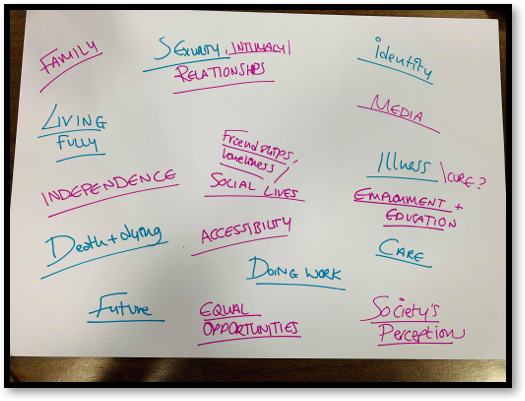

Our analytical approach in Living Life to the Fullest is built upon an assumption: that social theory can be generated through a meaningful engagement with a co‐researcher group of disabled young people. Our co‐researchers are theoretical provocateurs and theorists in their own right who, through their activism and writing, are challenging us to reconsider the meaning of life, death and disability. In short, co‐researchers’ contributions have been foundational to the theoretical development of the project. These critical contributions have meant that we are co‐producing theoretical knowledges of the lives of disabled children and young people with LL/LTIs and their families.
Co‐researching has impacted on our shared theoretical thinking in relation to life, death and disability. While co‐researchers have provided thoughtful counsel in relation to the methods and methodologies of the project, they have also offered their own perspectives through blogs and other multimedia resources that have profound impacts on the theoretical work of our study.
Analysing the narrative and artistic data that came from a variety of data collection methods took place virtually (online) and through coming together at an Analysis Retreat. Co-researchers both physically attended the Analysis Retreat, hosted in an accessible hotel over 3 days, and joined us virtually. While we have prioritised virtual methods as a way to connect across the project, coming together in the same physical space added a depth and meaning to our analytical journey. We were able to sit together, in comfortable surroundings, read through and discuss transcripts and co-researchers’ experiences of engaging with the stories of others.
At the Retreat, we spent time reviewing transcripts in order to affirm the coding framework. Conversation was often emotional and intense, as co-researchers own stories emerged through deep understandings of the stories of other young people. This took time, but enabled the organisation of a lot of narrative data, before we began a broad thematic analysis that took place through sets of conversations about themes. For example, theme conversations included: family; living fully; independence; death and dying; future; sexuality, intimacy and relationships; friendships and loneliness; social lives; accessibility; equal opportunities; doing work; identity; media; illness and cure; employment and education; care and society’s perceptions (see image below).

From discussions within each theme, we explored the meanings of participants’ stories to enable our key findings to emerge. Quite often, findings emerged across themes. As an example, a central emphasis that disabled young participants express across multiple themes was work and labour. One of our key findings was Young people routinely carried out multiple forms of work across the many spaces of their lives. This came from a deep understanding how young people spoke about the amount of responsibility and labour organising their personal are could take; the emotional work on themselves and others (for example, managing parents’ fear around their death); forms of identity work to ‘come to terms’ with a disabled identity as a young person; self-advocacy and fighting for access and services, and so on. These are just a few of the forms of works the disabled young participants in our research told us they carried out routinely as part of their everyday lives. Notably, while young people readily listed/articulated multiple forms of work and labour, they didn’t always acknowledge it as such, and added to this, such work/labour/expertise was seldom recognised by professionals around the young person, and for many, their parents and families.
Slowly and collectively, word by word, we co-wrote our key findings. This process took three days, but this was partly because we needed to schedule regular breaks and periods away from the room due to the physical and emotional labours of coding and analysing data in the intensity of a Retreat. It’s fair to say that much of this work was experimental – we had little guidance or knowledge of how to collectively and meaningfully explore data with our disabled young co-researchers. However, we centred co-researchers’ own engagements with the stories they had collected – what had they remembered? What surprised them? What was familiar? What forms of data haunted, scare, glowed, angered, resonated, excites, or confirms? Because co-researchers had collected the data, undertaking multiple interviews with their participants, building relationships and learning about the lives and stories of others, they could readily engage in such questions where analysis was, above anything else, meaningful conversation.
As part of the Retreat, we wanted to explore how co-researchers felt our analysis and findings should be used. We set the below questions, as points of entry to thinking about the potential impacts of our findings:
Questions
What are the most prevalent chapters in our collected stories?
What’s important to tell the world about the stories we have heard?
What has the potential to make real life impact in the lives of disabled young people with LL/LTIs and their families?
Who should we be telling about what we’ve found?
How will our analysis primarily be communicated? How does our analysis and findings fit with the book?
What followed, after the Retreat, was a short series of Skype meetings to honour and plan the ways we wanted to share data. Some of these are still in progress, even as the project comes to an end. You can read about much of this work by clicking on Making Change at the top of the page.
To read more about building a theoretical relationship as a Research Team of university academics and disabled young people, read our open access (free to all) article, Working the edges of Posthuman disability studies: theorising with disabled young people with life‐limiting impairments here.